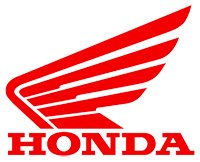
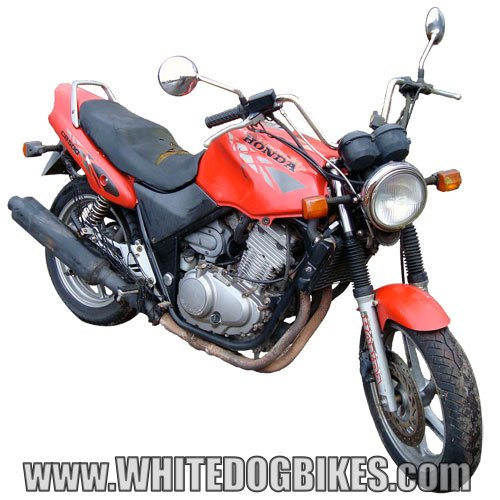
1995 Honda CB500 in red
Honda CB500 Specs…..
The Honda CB500 was a naked, 499cc commuter/roadster motorcycle produced by Honda in the UK between 1993 and 2003.
Honda also released a half faired version of the CB500 (known as the CB500S) between 1998 and 2003.
The CB 500 was a basic and popular mid range bike with legendary reliability, which is why it proved very popular with motorcycle couriers, training schools and first time riders.
The CB500 twin was replaced by Honda in 2004 by the CBF500 as the CB500 engine was unable to meet the new Euro 2 emissions regulations.
The main rivals to the CB500 were the Kawasaki ER5 and Suzuki GS500 E models.
Need parts for your CB500? Honda CB500 Twin parts on Amazon…
A little bit about the Honda CB 500 Twin…..
Basic model info… |
|
|---|---|
| Manufacturer: | Honda |
| Model: | CB500 |
| CC: | 499cc |
| Engine type: | Inline twin cylinder (4 stroke) |
| Years in production: | 1993 to 2003 (unfaired version) 1998 to 2003 (CB500-S, half faired version) More detailed release date and model info can in the ‘Models and years’ section below |
| Style of bike: | Commuter / tourer / roadster |
| Insurance: | Group 9 (of 17) |
| Succeeded by: | CBF500 (aka CB500F) |
| Competition: | Kawasaki ER5 and Suzuki GS500 E |
Servicing your bike? You’ll need a CB500 workshop manual…
Models and years (in the UK) |
|
|---|---|
| CB500-R (Dec 1993 to Dec 1994)….. | |
| Frame number started: | PC26-2000001 |
| Description: | Unfaired 499cc twin cylinder, water cooled roadster with twin rear shock absorbers, 17 inch, 6 spoke cast wheels, round chrome surrounded headlamp, black 2 into 1 exhaust, alloy rear (pillion) grab handle and colour match front mudguard. The bike also single front disc brake with a Nissin caliper and rear drum brake. |
| Available colours: | Green, black or red |
| Price (new): | £3655 for an ‘L’ reg £3730 for an ‘M’ reg |
| CB500-R (Jan 1995 to Oct 1995)….. | |
| Frame number started: | |
| Description: | Same as above model with another colour added to the range. |
| Available colours: | Green, black, blue or red |
| Price (new): | £3870 for an ‘M’ reg £4085 for an ‘N’ reg |
| CB500-T (Nov 1995 to Oct 1996)….. | |
| Frame number started: | PC32A-000001 |
| Description: | Same as above model. |
| Available colours: | Green, black or blue |
| Price (new): | £4085 for an ‘N’ reg £4085 for an ‘P’ reg |
| CB500-V (Nov 1996 to Nov 1997)….. | |
| Frame number started: | PC32A-100001 |
| Description: | Same as above model but now with a rear disc brake instead of a drum brake and Brembo brake calipers. Also a ‘Cup-Race’ version available in silver. |
| Available colours: | Green, red, black or titanium |
| Price (new): | £4085 for an ‘P’ reg £4085 for an ‘R’ reg |
| CB500-W (Dec 1997 to Oct 1998)….. | |
| Frame number started: | |
| Description: | Same as above model. |
| Available colours: | Black, red, yellow or silver |
| Price (new): | £4085 for an ‘R’ reg £4085 for an ‘S’ reg |
| CB500-X (Nov 1998 to Aug 1999)….. | |
| Frame number started: | ZDC9C32AOXF206241- |
| Description: | Same as above model. |
| Available colours: | Black, red or orange |
| Price (new): | £4085 for an ‘S’ reg £3495 for a ‘T’ reg £3495 for a ‘V’ reg |
| CB500-Y (Sept 1999 to Dec 2000)….. | |
| Frame number started: | ZDCPC32AOYF220001- |
| Description: | Same as above model with gold wheels (painted, not real gold obviously!) and new graphics. |
| Available colours: | Black, blue or red |
| Price (new): | £3545 for a ‘V’ reg £3545 for a ‘W’ reg £3775 for a ‘X’ reg |
| CB500-1 (Jan 2001 to Dec 2001)….. | |
| Frame number started: | |
| Description: | Same as above model with silver wheels. |
| Available colours: | Black, blue or red |
| Price (new): | £4090 for a ‘X’ reg £4090 for a ‘Y’ reg £4090 for a ’51’ reg |
| CB500-2 (Jan 2002 to Dec 2002)….. | |
| Frame number started: | |
| Description: | Same as above model. |
| Available colours: | Black, blue or red |
| Price (new): | £4085 for a ’51’ reg £4085 for an ’02’ reg £3704 for a ’52’ reg |
| CB500-3 (Jan 2003 to May 2003 – Discontinued)….. | |
| Frame number started: | |
| Description: | Same as above model. |
| Available colours: | Black, blue or red |
| Price (new): | £3704 for a ’52’ reg £3704 for an ’03’ reg |
Honda CB500 Sport (aka CB500-S, half faired version)… |
|
|---|---|
| CB500-SW (Feb 1998 to Oct 1998)….. | |
| Frame number started: | |
| Description: | Basically the same as the unfaired CB500 with a half fairing with the clocks built in and underseat storage for a ‘U’ lock. Also has front and rear disc brakes (same as the later CB500’s). |
| Available colours: | Black, red or yellow |
| Price (new): | £4245 for an ‘R’ reg £4290 for an ‘S’ reg |
| CB500-SX (Nov 1998 to Aug 1999)….. | |
| Frame number started: | ZDCP32EOXF306261- |
| Description: | Same as above model. |
| Available colours: | Black, red or orange |
| Price (new): | £4290 for an ‘S’ reg £3850 for an ‘T’ reg £3850 for an ‘V’ reg |
| CB500-SY (Sept 1999 to Dec 2000)….. | |
| Frame number started: | ZDCP32EOYF320001- |
| Description: | Same as above model but with gold wheels and new graphics. |
| Available colours: | Black, red or orange |
| Price (new): | £3895 for an ‘V’ reg £3895 for an ‘W’ reg £4050 for an ‘X’ reg |
| CB500-S1 (Jan 2001 to Dec 2001)….. | |
| Frame number started: | |
| Description: | Same as above model but with silver wheels. |
| Available colours: | Black, metallic red or metallic blue |
| Price (new): | £4050 for a ‘X’ reg £4050 for a ‘Y’ reg £4050 for a ’51’ reg |
| CB500-S2 (Jan 2002 to Dec 2002)….. | |
| Frame number started: | |
| Description: | Same as above model. |
| Available colours: | Black, metallic red or metallic blue |
| Price (new): | £4050 for a ’51’ reg £4050 for an ’02’ reg £4050 for a ’52’ reg |
| CB500-S3 (Jan 2003 to Mar 2003)….. | |
| Frame number started: | |
| Description: | Same as above model. |
| Available colours: | Black, metallic red or metallic blue |
| Price (new): | £3599 for a ’52’ reg £3599 for an ’03’ reg |
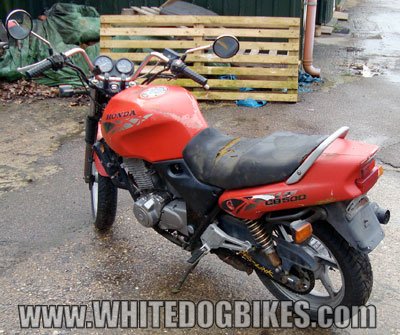
Honda CB500 Twin rear view (1995 model in red)
Engine and gearbox specs….. |
|
|---|---|
| Displacement: | 499 cc |
| Engine type: | Inline 2 cylinder |
| Stroke: | 4 stroke |
| Bore×Stroke: | 73×59.6mm |
| No. of cylinders: | 2 (inline) |
| Engine revs to (redline): | 10,500 rpm |
| Cam shaft configuration: | DOHC (double overhead cam – chain driven) |
| Compression ratio: | 10.5:1 |
| Cylinder compression pressure: | 14 bar (203 psi) |
| Valves: | 8 valve (4 per cylinder) |
| Spark plug: | NGK CR8EH-9 (x2) |
| Spark plug gap: | 0.8 to 0.9mm |
| Firing order: | 1 – 2 |
| Engine oil: | 10w40 API SG or higher
|
| Engine oil capacity: | 3.1 litres |
| Engine oil drain bolt location: | Bottom/underneath of the engine |
| Oil filter type: | Canister type |
| Oil filter: | Hiflo HF303 / Filtrex OIF006 |
| Oil filter torque: | 10nm |
| Oil pressure: | 2.4 bar (@ 2000 rpm) |
| Cooling system: | Liquid cooled |
| Cooling system capacity: | 2 litres |
| Clutch: | Wet (oil immersed) multiplate clutch |
| Clutch operation: | Cable |
| Clutch lever free play: | 10 to 20mm |
| Gearbox: | 6 Speed manual (1st gear down, 2nd to 6th gears up, neutral between 1st and 2nd gears) |
| BHP: | 57 bhp |
| Torque: | 35 ft/lb |
| Top speed (claimed): | 120mph |
| Quater mile time (claimed): | 13.2 seconds |
| Piston ring to cylinder bore clearance: | New: 0.010mm / Max 0.045mm |
| Valve clearance (inlet): | 0.16mm (+/- 0.02mm) (when cold) |
| Valve clearance (exhaust): | 0.25 (+/- 0.02mm) (when cold) |
| Idle speed: | 1,300rpm (+/- 100) |
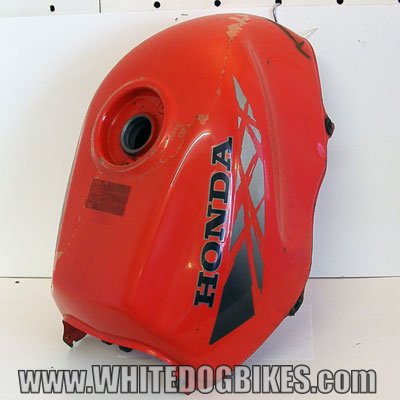
Honda CB500 petrol tank in red
Final drive stuff….. |
|
|---|---|
| Final drive: | Chain |
| Front sprocket: | 15 teeth |
| Rear sprocket: | 40 teeth |
| Chain pitch/length: | 525 pitch / 108 links |
| Chain free play: | 30 to 40mm |
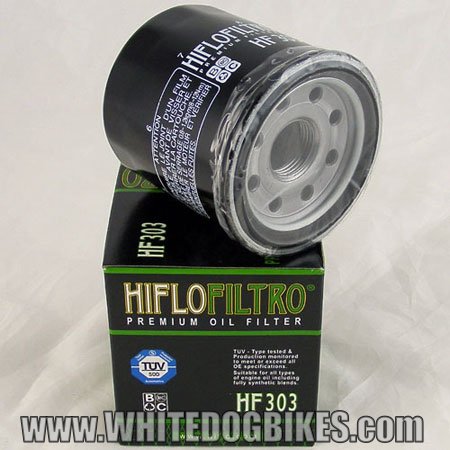
Honda CB500 canister type oil filter (all years, faired and unfaired models. Hiflo HF303)
Carb, fuel and oil stuff….. |
|
|---|---|
| Fuel system: | Carburetor |
| MPG (average): | 50 miles per gallon (very approx)
|
| Fuel tank range (approx – see above): | 200 miles |
| Fuel tank capacity: | 18 litres |
| Fuel type: | Unleaded petrol (91 octane grade – aka standard petrol from your local garage) |
| Carb make: | Keihin (2x) |
| Carb type: | VBNO (34mm flat-slide carbs) |
| Pilot screw opening: | 0.5 turns |
| Throttle grip free play: | 2 to 6mm |
| Engine oil: | 10w40 API SG or higher
|
| Engine oil capacity: | 3.1 litres |
| Engine oil drain bolt location: | Bottom/underneath of the engine |
| Oil filter type: | Canister type |
| Oil filter: | Hiflo HF303 / Filtrex OIF006 |
| Oil filter torque: | 10nm |
| Oil pressure: | 2.4 bar (@ 2000 rpm) |
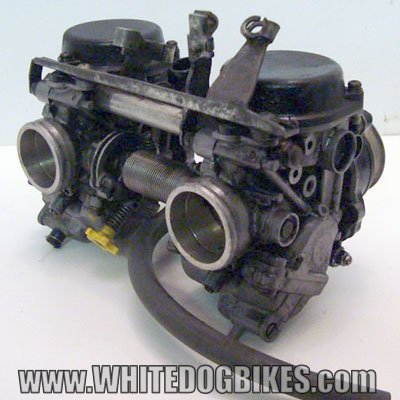
Set of carbs from a 1995 Honda CB500-R
Electric stuff….. |
|
|---|---|
| Ignition type: | Electronic CDI |
| Starter: | Electric start |
| Electrical system voltage: | 12 volts |
| Battery voltage (fully charged): | 13 to 13.2 volts |
| Battery amps per hour: | 8 a/h |
| Battery will need charging if below: | 12.3 volts |
| Battery charging current (normal): | 0.9 amps on a 5 to 10 hour charge |
| Regulated voltage: | 14 to 15.5 volts (@ 5000 rpm) |
| Spark plug: | NGK CR8EH-9 (x2) |
| Spark plug gap: | 0.8 to 0.9mm |
| Spark plug tightening torque: | 12nm |
| Spark plug ignition: | 2 x coil |
| Battery: | CTX9-BS / YTX9-BS / CBTX9-BS
|
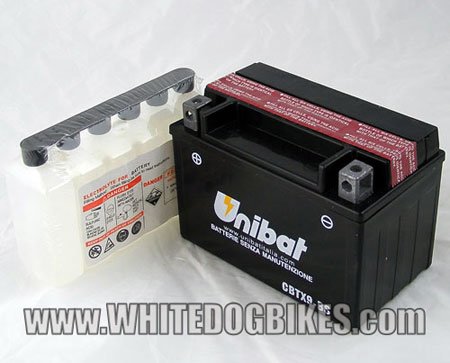
1993 to 2003 Honda CB500 battery (YTX9-BS). This battery fits both the half faired and unfaired models
Shocks, brakes and wheel specs….. |
|
|---|---|
| Front wheel type: | 6 spoke cast wheel |
| Front tyre size: | 110/80-17 |
| Front tyre pressure: | 29psi (2 bar) |
| Front wheel spindle torque: | 60nm |
| Front wheel spindle clamp bolt torque: | 27nm |
| Rear wheel type: | 6 spoke cast wheel |
| Rear tyre size: | 130/80-17 |
| Rear tyre pressure: | Solo: 31psi (2.2 bar) / With pillion: 36psi (2.5 bar) |
| Rear wheel spindle torque: | 90nm |
|
|
| Front brake: | Single hydraulic disc brake with 2 piston caliper |
| Front brake disc: | 296mm single disc. Part no: EBC MD1008 (1x) |
| Front brake pad (1993 to Oct 1996 – CB500 R/T, drum rear brake models): | EBC FA196 (1x) |
| Front brake pad (Nov 1996 on – Faired and unfaired disc rear brake models): | EBC FA209 (1x) |
| Rear brake (1993 to Oct 1996 – CB500 R/T, drum rear brake models): | Drum brake |
| Rear drum brake pad: | EBC H321 |
| Rear brake (Nov 1996 on – Faired and unfaired disc rear brake models): | Single hydraulic disc brake with single piston caliper |
| Rear brake disc: | Single 240mm disc. Part no: EBC MD1020 (1x) |
| Rear brake pad: | EBC FA213 (1x) |
| Brake fluid (front and rear): | DOT 4 brake fluid |
| Front suspension: | Telescopic forks |
| Front fork stanchion diameter: | 37mm |
| Recommended fork oil: | 10w (medium weight) fork oil |
| Fork oil volume: | 320 ml (per fork) |
| Rear Suspension: | Twin rear shock absorbers |
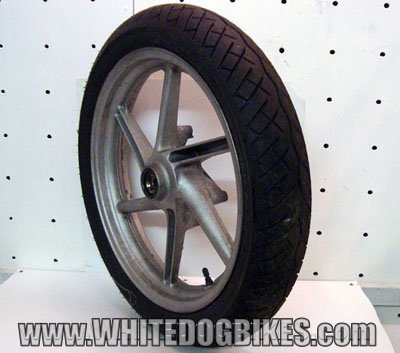
110/80-17 Front wheel from a CB500
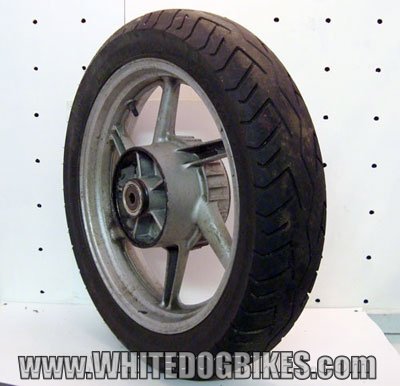
1995 CB500 17 inch rear wheel with drum brake
Weights, measures ‘n stuff….. |
|
|---|---|
| Overall length: | 2,090mm |
| Overall width: | 720mm |
| Overall height: | 1,050mm (CB500) 1,160mm (CB500S) |
| Wheelbase: | 1,430mm (CB500) 1,435mm (CB500S) |
| Seat height: | 775mm |
| Ground clearance: | 145mm |
| Dry weight (no oils, fluids etc): | 170kg (CB500 R/T models) 173kg (CB500 V/W/X/Y/1/2/3 models) 179kg (CB500S Sport models) |
| Kerb weight (with oil, coolant etc – approx): | 190kg |
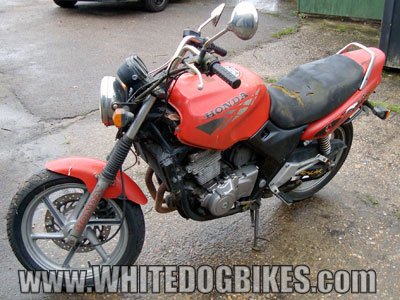
Side view of a CB500-R (1995 model)
Useful torque settings….. |
|
|---|---|
| Cam cover: | 10nm |
| Cylinder head (stage 1): | 24nm |
| Cylinder head (stage 2): | 48nm |
| Spark plugs: | 12nm |
| Front wheel spindle: | 60nm |
| Front wheel spindle clamp: | 27nm |
| Rear wheel spindle: | 90nm |
| Front brake caliper bolt: | 30nm |
| Rear brake caliper bolt: | 30nm |
| Engine oil drain bolt: | 29nm |
| Oil filter: | 10nm |
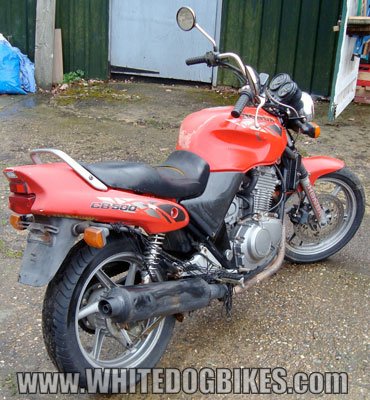
1995 CB500-R in red. Earlier model with a rear drum brake.
Service stuff….. |
|
|---|---|
| Servicing your bike? You’ll need a 1993 – 2003 CB500 workshop manual… | |
| Engine oil | |
| Engine oil change frequency: | Every 12,000km (approx 7,456 miles) or 12 months |
| Engine oil: | 10w40 API SG or higher
|
| Engine oil capacity: | 3.1 litres |
| Engine oil drain bolt location: | Bottom/underneath of the engine |
| Oil filter: | Hiflo HF303 / Filtrex OIF006 |
| Oil filter torque: | 10nm |
| Chain drive | |
| Final drive chain frequency: | Now repeat after me… ‘I MUST LUBE MY CHAIN LITTLE AND OFTEN!!’ |
| Chain and sprocket size: | 108 link / 525 pitch Chain, 15 tooth front and 40 tooth rear sprocket |
| Hydraulic brake system (front and rear) | |
| Brake fluid check frequency: | Check every 12 months or 6,000km (approx 3,728 miles) |
| Brake fluid change frequency: | Change every 24 months or 18,000km (approx 11,185 miles) |
| Brake fluid: | DOT 4 brake fluid |
| Fork oil | |
| Front fork oil check frequency: | Check every 12,000km (approx 7,456 miles) or 12 months |
| Recommended fork oil: | 10w (medium weight) fork oil |
| Fork oil volume: | 320ml (per fork) |
| Cooling system | |
| Coolant check frequency: | Check every 12,000km (approx 7,456 miles) or 12 months |
| Change every: | 36,000 km (approx 22,369 miles) or 24 months |
| Cooling system: | Liquid cooled |
| Cooling system capacity: | 2 litres |
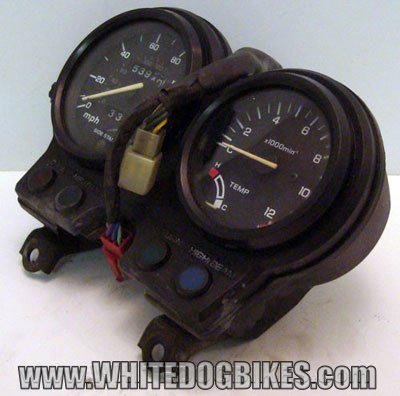
Clocks from and unfaired Honda CB500
Frame number location…..
The frame number is usually stamped onto the right side of the headstock (the front part of the frame just below the handle bars).
Useless stuff…..
Middleweight commuter/roadster style bike from Honda that was released in 1993. Rumor has it that Honda designed the bike to last for 190,000 miles. Although you won’t find many models with 190,000 miles on the clocks, they were capable of huge mileage, fairly simple in design and easy to work on which is why they proved popular with commuters, couriers (<< avoid ex courier bikes though!) and motorbike training schools.
They also had good, solid and confidence inspiring handling which is partly why training schools used them as 1st time ‘big bike’ riders found them easy to get along with (and, at 57bhp you could take your ‘Direct Access’ course on one. This allowed a rider who passed to ride any bike regardless of power or cc after they passed it. You had to be over 21 to do this course and had to take it on a bike over 50bhp).
The CB500 didn’t have much in the way of updates during it’s 10 year life, a rear brake disc was added and the Nissin calipers were dropped for Brembo calipers for the November 1996 release and a half faired version was released in 1998 (known as the CB500 Sport).
The CB500 did have it’s own racing series called the CB500 Cup. Honda released a ‘Cup-Race’ version of the bike in 1996. The CB500 Cup was renamed to the Thundersport 500 in 2009 to allow (mainly) Kawasaki ER5 and Suzuki GS500E riders to enter.
The CB500 was discontinued in 2003 as the 499cc motor was unable to meet Euro 2 emissions regulations.
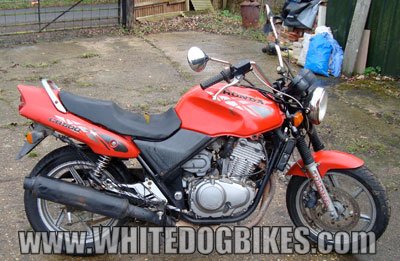
Side view of a CB500-R (rear drum brake model)
Buying advice…..
Firstly, if your thinking of buying one always HPI check it (there’s still loads about so no point risking getting stuck with a lemon!).
These are good, solid bikes and are ideal for 1st time ‘big bike’ riders. Mileage isn’t really anything to worry about (within reason!), but obviously a bike that’s had frequent oil changes is likely to be better.
As the bike was a naked/unfaired bike there’s wasn’t alot of fairing to damage and indicators, headlights etc could be easily replaced, if damaged, with aftermarket parts.
Exhaust downpipes and headers do rot though (mild steel!), so in the unlikely event of the bike having the original headers, best to budget for replacing them (however, end can’s and downpipes are readily available and not stupidly overpriced).
It’s probably best to avoid ex courier bikes or bikes used for racing (these were used in the Thundersport 500 series), race bikes will have drilled sump plugs, caliper bolts, scrapes etc, courier bikes will look like they’ve been round the world twice (take it from an ex courier, it’s a blerdy hard life for a bike!!).
Ex training school bikes can be ok, but look for damage as, again, they can get a hard life (and budget for a new clutch!).
The only other thing to consider when buying one is the age. The youngest of these beasties will be over 15 years old now, so if your buying one give it a good check over, especially rear shocks, fork stanchion condition (helps if the forks have had gaitors fitted), radiator (damage, leaks look for white water trails from the rad of pipework), handle bar switches, ignition, battery etc.
Obviously, it’s worth paying a bit more for a lower mileage bike with a small rainforest of service paperwork then one of the ‘barn find’ type bikes that seem to be cropping up regularly (barn find = nicked…… Usually! 😀 ).
Happy biking 🙂
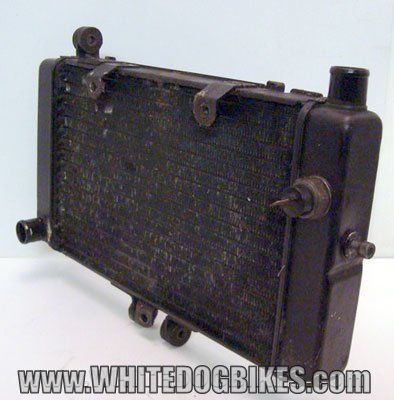
CB500 Radiator
Sources / Thanks to / Useful CB500 sites:
CB500 article on Wikipedia
Another useful CB500 article
www.cb500club.net Loads of helpful owners and info
www.thundersportgb.com Home of the Thundersport 500 series (was originally the CB500 Cup).
If you’ve got any questions, comments or suggestions please feel free to leave them below 🙂
Disclaimer: The information on this page is correct to the best of our knowledge. But the info should NOT be taken as 100% accurate as we can, occasionally make mistakes!

Leave a Reply